Mirror, mirror on the wall, who is the fairest of them all?
A symbol for self acknowledgement better than any selfie, a symbol for the deformation of reality, a means to connect to a magical world and to learn the truth, what and who would we be without glass mirrors?
Historians report that metal mirrors were used in ancient Mesopotamia, Egypt and South America. thousands of years BC. As for the looking glass, it seems it was invented in northern Europe…
It’s not clear though when exactly glassblowers in Europe improved the method of coating glass with a tin-mercury amalgam. Germans and French from Lorraine were already able to make glass mirrors in the 11th century, and so, after unsuccessfully trying to produce glass mirrors in Venice in 1318, Murano glassblowers decided to hire a German artisan to learn. The mysterious thing is that no one knows what happened to this guy: he simply disappeared after he revealed the secret 🙁
In 1369, eventually, a real production of mirrors in glass started on the famous Venetian island. Here is the arrival of the mirror brought by cherubs in a fresco by Giambattista Tiepolo in Ca’ Rezzonico palace.
Mirrors at that time and all throughout the 18th century were particularly expensive. As luxury products they featured in the hands of wealthy women and they became an important status symbol in their dowery. In her detailed research on inventories made in Venice in the 16th century, Isabella Palumbo Fossati Casa points out that the objects of highest value in Venetian homes, not to mention the jewels, were the bed, the clothes and… the mirror. Both in patrician and middle class homes there was always a mirror.
They were all small and a precious handle was added to the reflecting looking glass. Or rich frames would enhance the beauty of this object. But why small? The truth is that it was really difficult to make a large glass mirror!
Originally the glass artisans were making the mirror in this way: they blew the glass into a cylinder that was then heated, butterflied in the middle and laid down. So, the smaller the surface, the easier it was to get a perfect pane, beautifully transparent with no bubbles, waves or impurities. It was then polished with a refined powder and several oxides.
Also, making a mirror proved to be a very unhealthy job. When the glass pane was laid down then another glass pane was placed on top and through a hole, liquid mercury was poured in between, pressed and spread all over the surface releasing dangerous exhalations.
It was only in the 19th century when French artisans started using a roll to straighten the lead-free glass pane that mirrors could reach larger dimensions! As for safety mercury would be replaced with silver nitrate.
The competition between Murano maestri da quari (mirror masters) and the French ones is another fascinating aspect of the story. It was not just the invention of the roll that made it possible for the French to get a new section of the market, but it was also their ability in using electricity instead of man powered lathes to grind the glass panes.
But the best story is for sure that of the Hall of Mirrors in Versailles. At that time, Jean Baptiste Colbert, the Minister of Finances for King Louis XIV in 1678, hired Murano glass blowers and brought them to France. When learning what happened, the Republic of Venice reacted with no mercy. Putting in prison the family members of the glass blowers that had betrayed and assassinating some of these expatriates. One of them was Girolamo Barbini, but he came back safe… it seems the compromise for his safety was that he would boycott the production in France 🙂
If for King Louis XIV mirrors would be the perfect way to decorate his sumptuous palace, where would you use a mirror and what for? Well, when searching in the history of this object, it feels you are in a mirror room 🙂
Here are some ideas of inspiration… First, the practical ones:
A mirror could be positioned in a way to reflect daylight and illuminate the dark corners of the house…
A mirror was a must in the coiffeuse of the lady for her make-up… Here are two famous paintings by Pietro Longhi in Ca’ Rezzonico palace:
And by Giacomo Franco, dated 1610, typical Venetian lady:
A mirror was to enlarge the real space creating optical illusion in a ball room or in a café
A convex mirror would be used to check in the banks the whole room as a sort of internal videocamera
And then the fancy ones:
… more originally a mirror would never be missing in the intimate rooms of a private casino where in the 18th century all was designed to create the atmosphere of seduction and enhance pleasure and mystery…
Or as patriarch Giovanni Grimani used convex tiny mirrors on the vaulted ceiling of a room in his palace near Campo Santa Maria Formosa where among white stucco relieves and gold leaf the convex little mirrors would reflect the light of the candles as shining stars…
Or as in the well-known clock in the Frari church designed by Francesco Pianta in the middle of the 17th century, the background of the clock is a mirror reflecting your face while you check what time it is and allegories of time decorate the intricate walnut wooden frame of the clock… So while you watch yourself, the mirror reminds you of the fragility of life…
Or they would reflect, usually in the bedroom, the painted portrait of the owner, et voilà, what an exquisite idea, you can look at yourself in a mirror but you never grow old or look tired 🙂
It was a great morning the one I spent with Mr Guido Barbini on the island of Murano early September.
Mr Barbini runs one of the most important artistic glass mirror factories we cannot be but proud of. First he mentioned all the other factories on the island making glass: S.A.L.I.R. with Luigi Toso and Mario d’Alpaos, Ongaro e Fuga, Vincenzo and Giovanni Barbini.
He was so welcoming and patient with all my questions and started drawing to explain how you make a mirror and then brought me to see the different phases of the production, all by hand. While the glass panes come from Belgium, the rest is all made here in these rooms in Murano.
The design and the composition, the engraving of the various motifs with the stone wheel, the preparation of every single piece and finally the pouring over the pane of the silver nitrate and the shining mirror appearing. And the collaboration with the interior designer and architect Philippe Starck or with the American artist Jeff Koons or the prestigious hotels all over the world and luxurious private homes in the Middle East or in Russia.
When I met Mr Barbini and the whole history behind him, his ancestors, his island, I thought of one more significance linked to mirrors. In his Iconology, Cesare Ripa in 1593 so describes the allegory of Prudence: a lady with two faces with a snake around her arm watching herself in a mirror. Prudence is connected to the past history, arranging the present time and predicting the future, because those that are not able to preserve the past don’t know what they own and what expects them… and that’s what the mirror is for!
by Luisella Romeo
registered tourist guide in Venice, Italy
www.seevenice.it



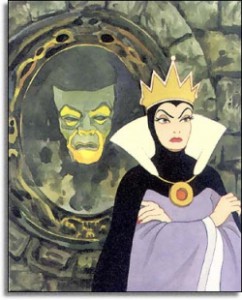
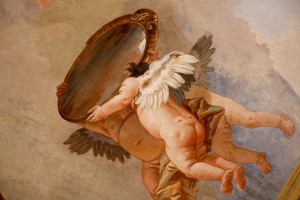
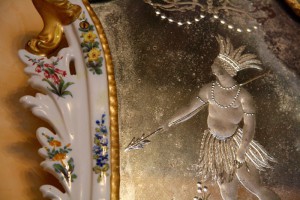
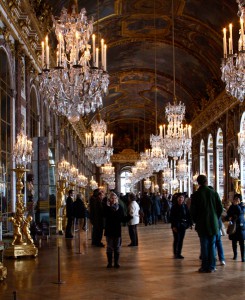
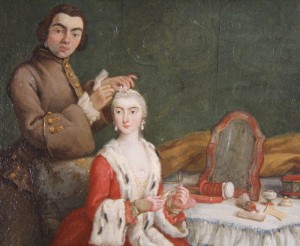
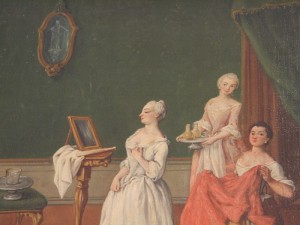

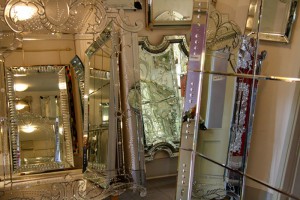
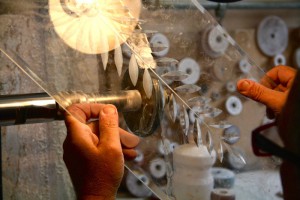
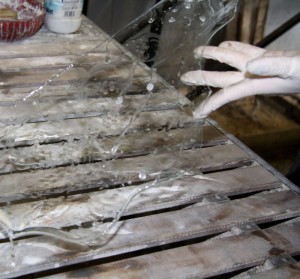
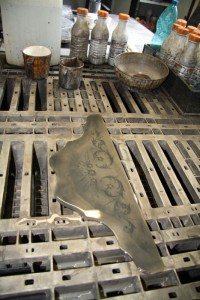
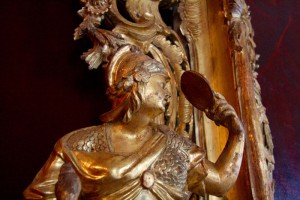



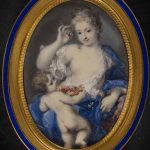


Thanks for sharing the history of how mirrors came to be and how competition with France pushed the Venetians to try new techniques.
What a wonderful, witty and beautifully illustrated article! I appreciate so much that you paired this history with illustrations showing the significance and uses of Murano glass mirrors within society and their reflections in other forms of art. I can not thank you enough! Your work has lifted my spirits for the whole day.
Yours,
Marjorie
Simply great and definitely elegant!!!! …. Grazie Luisella!
Giovanni
Grazie, Giovanni!!!